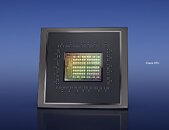- Joined
- Oct 9, 2007
- Messages
- 47,449 (7.50/day)
- Location
- Hyderabad, India
| System Name | RBMK-1000 |
|---|---|
| Processor | AMD Ryzen 7 5700G |
| Motherboard | ASUS ROG Strix B450-E Gaming |
| Cooling | DeepCool Gammax L240 V2 |
| Memory | 2x 8GB G.Skill Sniper X |
| Video Card(s) | Palit GeForce RTX 2080 SUPER GameRock |
| Storage | Western Digital Black NVMe 512GB |
| Display(s) | BenQ 1440p 60 Hz 27-inch |
| Case | Corsair Carbide 100R |
| Audio Device(s) | ASUS SupremeFX S1220A |
| Power Supply | Cooler Master MWE Gold 650W |
| Mouse | ASUS ROG Strix Impact |
| Keyboard | Gamdias Hermes E2 |
| Software | Windows 11 Pro |
Last week, we got confirmation from the highest levels of Dell and NVIDIA that the latter is making a client PC processor for the Windows on Arm (WoA) AI PC ecosystem that only has one player in it currently, Qualcomm. Michael Dell hinted that this NVIDIA AI PC processor would be ready in 2025. Since then, speculation has been rife about the various IP blocks NVIDIA could use in the development of this chip, the two key areas of debate have been the CPU cores and the process node.
Given that NVIDIA is gunning toward a 2025 launch of its AI PC processor, the company could implement reference Arm IP CPU cores, such as the Arm Cortex X5 "Blackhawk," and not venture out toward developing its own CPU cores on the Arm machine architecture, unlike Apple. Depending on how the market recieves its chips, NVIDIA could eventually develop its own cores. Next up, the company could use the most advanced 3 nm-class foundry node available in 2025 for its chip, such as the TSMC N3P. Given that even Apple and Qualcomm will build their contemporary notebook chips on this node, it would be a logical choice of node for NVIDIA. Then there's graphics and AI acceleration hardware.

It's being speculated that NVIDIA's AI PC processor could integrate an iGPU based on the "Blackwell" graphics architecture. This would give the chip first-rate graphics acceleration capabilities, including for DirectX 12 Ultimate and Vulkan. As for AI acceleration—the whole point behind this chip, we predict that the iGPU with its tensor cores would double up as the AI coprocessor. This would free up silicon real-estate for NVIDIA, the company can simply expose the GPU as an NPU virtual device to Windows, and use a series of translation layers to TensorRT. Given that Microsoft's requirement for an NPU capable of accelerating a local session of Copilot+ is just 45 AI TOPS, this should be easily done for NVIDIA. Lastly, 2025 will see LPDDR6 hit mainstream for mobile applications, such as smartphones, tablets and ultraportable PCs. It's likely that NVIDIA will implement this memory standard.
View at TechPowerUp Main Site | Source
Given that NVIDIA is gunning toward a 2025 launch of its AI PC processor, the company could implement reference Arm IP CPU cores, such as the Arm Cortex X5 "Blackhawk," and not venture out toward developing its own CPU cores on the Arm machine architecture, unlike Apple. Depending on how the market recieves its chips, NVIDIA could eventually develop its own cores. Next up, the company could use the most advanced 3 nm-class foundry node available in 2025 for its chip, such as the TSMC N3P. Given that even Apple and Qualcomm will build their contemporary notebook chips on this node, it would be a logical choice of node for NVIDIA. Then there's graphics and AI acceleration hardware.

It's being speculated that NVIDIA's AI PC processor could integrate an iGPU based on the "Blackwell" graphics architecture. This would give the chip first-rate graphics acceleration capabilities, including for DirectX 12 Ultimate and Vulkan. As for AI acceleration—the whole point behind this chip, we predict that the iGPU with its tensor cores would double up as the AI coprocessor. This would free up silicon real-estate for NVIDIA, the company can simply expose the GPU as an NPU virtual device to Windows, and use a series of translation layers to TensorRT. Given that Microsoft's requirement for an NPU capable of accelerating a local session of Copilot+ is just 45 AI TOPS, this should be easily done for NVIDIA. Lastly, 2025 will see LPDDR6 hit mainstream for mobile applications, such as smartphones, tablets and ultraportable PCs. It's likely that NVIDIA will implement this memory standard.
View at TechPowerUp Main Site | Source





 Call it fortune or a fluke, it happened.
Call it fortune or a fluke, it happened.
